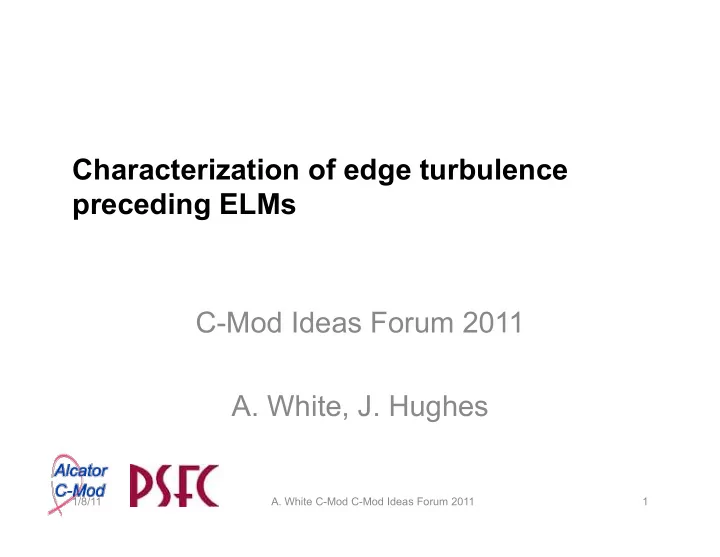

Characterization of edge turbulence preceding ELMs C-Mod Ideas Forum 2011 A. White, J. Hughes 1/8/11 A. White C-Mod C-Mod Ideas Forum 2011 1
Past work has shown that changes in coherent oscillations ( ∆ f << f peak ) and high-frequency turbulence ( ∆ f~f peak ) do occur before and after ELMs • Low frequency (5-25 kHz) coherent fluctuations have been observed to precede Type I ELMs at JT60 and ASDEX (magnetics, ne, Te), and these precursors are consistent with predictions for ELM onset based on peeling ballooning stability models 1 • In limited H-mode plasmas on TEXTOR, the evolution of high frequency, broadband turbulence in between edge perturbations identified as Type III ELMS indicated characteristic reductions in turbulence, with higher turbulence levels after the ELM crash 2 • In low pedestal beta DIII-D discharges, density turbulence in the pedestal changes very little during ELM-free phases and in high pedestal beta discharges density and magnetic turbulence are observed to increase before the first ELM 3 • Excellent suite of edge diagnostics and operational capability to explore ELMy H-modes and high-confinement regimes with very rare ELM events (I-mode and EDA H-mode) puts C-Mod in prime position to characterize turbulence preceding ELM events and look for precursors in the broadband turbulence. 1/8/11 A. White C-Mod C-Mod Ideas Forum 2011
The goal of this experiment is to carefully track temporal changes in edge turbulence preceding an ELM By tracking changes in edge turbulence before an ELM, we hope to identify if there are any ELM precursors that can be seen in the turbulence Standard characteristics of interest that might exhibit changes just before and ELM occurs: 1. Probability distribution function/Bispectrum with symmetric normalization -- measure of non-gaussian statistics of turbulence 2. Frequency spectrum/auto-correlation – measure of temporal scales of turbulence 3. Wavenumber spectrum/correlation length – measure of spatial scales of turbulence 4. Bicoherence -- measure of quadratic, nonlinear coupling 5. Relative Amplitude – strength of turbulence driver One analysis goal would be to perform as much identical analysis on data from different diagnostics as possible 1/8/11 A. White C-Mod C-Mod Ideas Forum 2011
Machine time: 1-2 days 1. Look a two types of ELMy plasmas: A. ELMy H-mode: Large, well spaced ELMs or tiny, rapid ELMs? B. ELM-free H-mode or I-mode that has only occasional ELMS 2. Track changes in edge turbulence measured with reflectometer, GPI, (Ohmic ELMy H-modes?? langmuir probes) PCI, etc. before the ELMs. Track magnetic fluctuations. 3. Does turbulence change in regular manner preceding ELMs? If the turbulence changing before the first ELM in an otherwise ELM-free H-mode or I-mode? 4. Is there a knob to turn? • Use insights/guidance from Hughes from his C-Mod EPED studies to plan target conditions where big changes in turbulence may be expected before an ELM due to the stability of the edge turbulence (Peeling ballooning modes? Kinetic ballooning modes?) References: 1 Leonard, 2005, GENERAL ATOMICS REPORT A25161 2 Soldatov, 2010, Plasma Phys. Control. Fusion 52 (2010) 085001 3 Wang, 2007, Journal of Nuclear MaterialsVolumes 363-365, 15 1/8/11 A. White C-Mod C-Mod Ideas Forum 2011
Recommend
More recommend